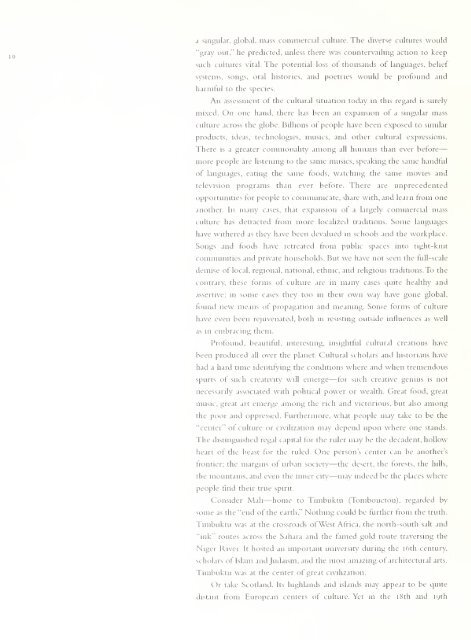SCOTLAND - Smithsonian Digital Repository - Smithsonian Institution
SCOTLAND - Smithsonian Digital Repository - Smithsonian Institution
SCOTLAND - Smithsonian Digital Repository - Smithsonian Institution
You also want an ePaper? Increase the reach of your titles
YUMPU automatically turns print PDFs into web optimized ePapers that Google loves.
—<br />
a singular, global, mass coniiiiercial culture. The diverse cultures would<br />
"gray out," he predicted, unless there was countervailing action to keep<br />
such cultures vital. The potential loss ot thousands of languages, belief<br />
systems, songs, oral histories, and poetries would be profound and<br />
harmful to the species.<br />
An assessment of the cultural situation today m this regard is surely<br />
mixed. On one hand, there has been an expansion of a singular mass<br />
culture across the globe. Billions of people have been exposecl to similar<br />
products, ideas, technologies, musics, and other cultural expressions.<br />
There is a greater commonality among all humans than ever before<br />
more people are listening to the same musics, speaking the same handtul<br />
of languages, eating the same foods, watching the same movies and<br />
television programs than ever betore. There are unprecedented<br />
opportunities for people to communicate, share with, and learn from one<br />
another. In many cases, that expansion of a largely commercial mass<br />
culture has detracted from more localized traditions. Some languages<br />
have withered as they have been devalued in schools and the workplace.<br />
Songs and foods have retreated from public spaces into tight-knit<br />
communities and private householcis. But we have not seen the tull-scale<br />
demise of local, regional, national, ethnic, and religious traditions. To the<br />
contrary, these t'orms of culture are in many cases quite healthy and<br />
assertive; in some cases they too in their own way have gone global,<br />
found new means of propagation and meaning. Some forms ot culture<br />
have even been rejuvenateci, both m resisting outside influences as<br />
well<br />
as in embracing them.<br />
Profound, beautiful, interesting, insightful cultural creations have<br />
been produced all over the planet. Cultural scholars and historians have<br />
had a hard time identifying the conditions where and when tremendous<br />
spurts of such creativity will emerge—for such creative genius is not<br />
necessarily associated with political power or wealth. CJreat tood, great<br />
music, great art<br />
emerge among the rich and victorious, but also among<br />
the poor and oppressed. Furthermore, what people may take to be the<br />
"center" of culture or civilization may depend upon where one stands.<br />
The distinguished regal capital for the ruler may be the decadent, hollow<br />
heart of the beast for the ruled. One person's center can be another's<br />
frontier; the margins of urban society—the desert, the forests, the hills,<br />
the mountains, and even the inner city—may indeed be the places where<br />
people find their true spirit.<br />
Consider Mali—home to Timbuktu (Tombouctou), regarded by<br />
some as the "end of the earth." Nothing could be further from the truth.<br />
Timbuktu was at the crossroads of West Africa, the north-south salt and<br />
"ink" routes across the Sahara and the tamed gold route traversing the<br />
Niger River. It hosted an important university during the i6th century,<br />
scholars of Islam and Judaism, and the most amazing ot architectural arts.<br />
Timbuktu was at the center of great civilization.<br />
Or take Scotland. Its highlands and islands may appear to be quite<br />
distant from European centers of culture. Yet in the iNth and 19th
















